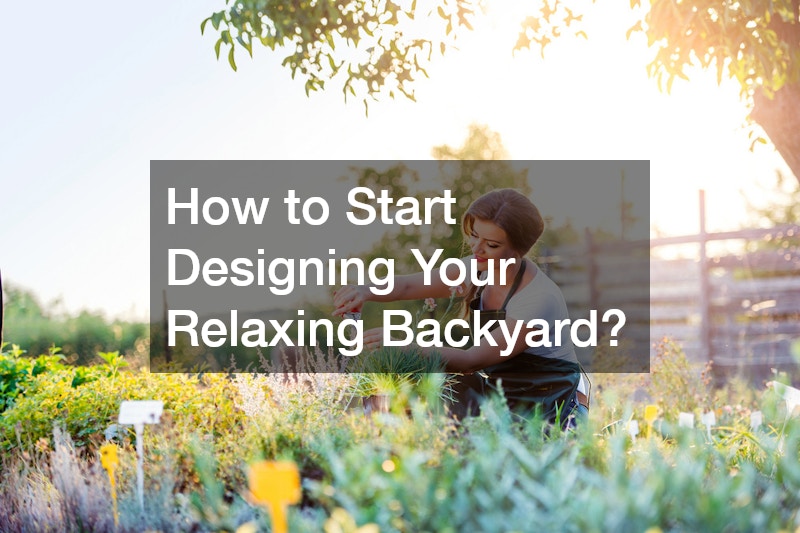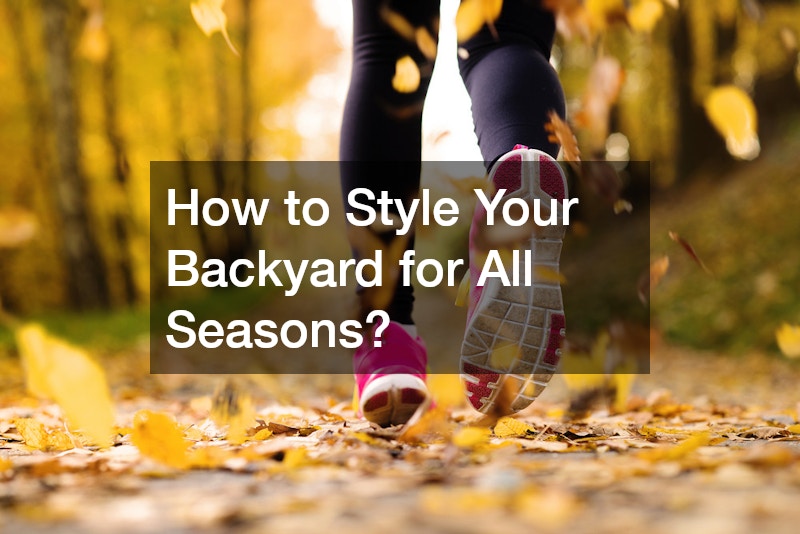A well-designed backyard can serve as an extension of your living space, providing a tranquil retreat from the hustle and bustle of daily life. More than just a patch of grass, your backyard has the potential to become a personalized sanctuary that promotes relaxation, entertainment, and even wellness. Whether you’re starting from scratch or enhancing an existing space, thoughtful backyard designs can dramatically improve your lifestyle and property value. In this article, we’ll explore how to create a functional and relaxing backyard retreat, addressing some of the most commonly asked questions and popular topics on the subject—from choosing the right plants and materials to selecting furniture, incorporating technology, and managing essential tasks like lawn care and lawn fertilizing.
How to Start Designing Your Relaxing Backyard?

Assess Your Space
Every successful backyard transformation begins with a careful assessment of your available space. Take note of your yard’s dimensions, natural sunlight, existing structures, and elevation. Observe how water drains during rainfall and which areas might benefit from shade or protection from wind. This is also a good time to evaluate your current lawn care practices, such as mowing frequency and lawn irrigation efficiency. Understanding the potential and limitations of your space helps lay a strong foundation for your project.
Define Your Purpose
Deciding how you want to use your backyard is crucial. Whether it’s a quiet spot for meditation, a space for entertaining guests, or an area for family play, your purpose will influence every decision from layout to lighting. If your goal includes aesthetic appeal, consider hiring a landscaping contractor to help define and execute a cohesive vision that meets your needs.
Set A Budget
Setting a realistic budget early on ensures you prioritize essential components without financial stress. Determine how much you’re willing to spend overall and allocate portions of your budget to specific categories such as furniture, landscape materials, lighting, and tech. Include possible costs for hiring a paving company for paver installations or a professional landscaping service for more extensive transformations. Consider reserving a portion of funds for ongoing maintenance or unexpected expenses during installation.
Choose A Theme
Choosing a cohesive theme brings unity and character to your backyard retreat. Whether you’re drawn to a tropical paradise, a minimalist zen garden, or a rustic countryside vibe, your theme will guide your choices in materials, color schemes, and decor. A consistent theme enhances relaxation by creating a harmonious visual experience.
Create A Layout Plan
Design a layout that supports both functionality and flow. Sketch out different zones such as seating areas, dining spaces, and garden beds. Consider pathways made from stone or brick paver installations that connect each area and how people will move through the space. A well-planned layout avoids clutter and encourages comfort, making it easier to enjoy the environment you’ve created.
What Are Essential Elements for a Relaxing Backyard?
Comfortable Seating
Seating is one of the most important features of any backyard retreat. Opt for deep-cushioned chairs, ergonomic loungers, or built-in benches with soft pillows. The key is to invite lingering—seating should not only look good but also offer hours of comfort, especially if you plan to spend long evenings outside.
Natural Elements
Bringing nature into your backyard increases its calming effect. Trees, shrubs, and flowers add texture and color while attracting birds and butterflies. Integrating natural stone, wood, and other organic materials into your landscape helps the space feel more grounded and relaxing.
Lighting Solutions
Proper lighting transforms a backyard into a magical retreat after sunset. String lights, lanterns, pathway lights, and embedded LED strips help create ambiance while improving safety. Solar-powered options are cost-efficient and environmentally friendly, adding beauty with minimal effort.
Privacy Features
Creating a sense of seclusion enhances relaxation. Add tall hedges, lattice screens, or retractable panels to block unwanted views. Features like trellises with climbing vines or bamboo fences can both shield and beautify your retreat without making it feel enclosed.
Water Features
Water has a universally calming effect. Consider adding a small pond, fountain, or waterfall. Even a modest tabletop water feature can bring the soothing sound of trickling water to your space, fostering relaxation and masking urban noise.
How to Choose the Right Plants?

Assess Climate and Soil
Before selecting plants, evaluate the climate in your region and test your soil. Choose plants that are well-suited to local weather conditions and require minimal alteration to thrive. This is also a good time to assess your lawn fertilizing needs to ensure healthy grass and plant life.
Decide on Color Schemes
Color significantly impacts mood. Cool colors like blue and purple can evoke calm, while warmer tones like red and orange energize the space. Decide on a palette that complements your overall design and theme, and ensure blooms are staggered throughout the seasons for continuous color.
Select Low-Maintenance Varieties
If relaxation is your goal, opt for plants that are resilient and low-maintenance. Succulents, ornamental grasses, and drought-tolerant perennials are great choices. These plants require less watering and upkeep, giving you more time to unwind.
Incorporate Aromatic Plants
Aromatic plants such as lavender, jasmine, and mint enhance your retreat through scent. Their natural fragrances promote stress relief and attract pollinators. Place them near seating areas or along walkways for an immersive sensory experience.
Group Plants for Impact
Group plants based on height, texture, and color to create focal points and visual interest. Mass plantings or repeating patterns across your yard can evoke a sense of order and cohesion, contributing to a calming atmosphere.
What Furniture Should You Include?

Durable Materials
Backyard furniture should be able to withstand the elements. Choose materials like teak, wrought iron, powder-coated steel, or synthetic wicker. These options resist fading, rust, and moisture damage, making them ideal for outdoor use.
Versatile Pieces
Select furniture that serves multiple functions. Ottomans that double as storage, benches with built-in planters, and extendable tables offer flexibility for different occasions, maximizing the use of your space.
Weather-Resistant Options
Ensure all cushions and fabrics are weather-resistant. Look for materials treated to repel water, resist UV rays, and resist mildew. Removable covers that are machine-washable add convenience and longevity.
Harmonizing with Design Style
Your furniture should reflect your backyard’s theme. Sleek, minimalist furniture suits a modern design, while wrought iron or wood complements traditional or rustic settings. The style should feel intentional and integrated with the overall aesthetic.
Space Efficiency
In smaller yards, prioritize space-saving furniture like folding chairs, stackable seating, or wall-mounted tables. Well-proportioned pieces keep the area from feeling crowded and maintain a sense of openness.
How to Create a Sense of Privacy?
Fences and Screens
Physical barriers like wood fences, bamboo screens, or vinyl panels create instant privacy. They are especially useful in urban areas where neighboring homes are close by. Choose a style that complements your overall design.
Landscaping for Seclusion
Tall shrubs, trees, and layered plantings can form natural walls that blend into the landscape. Arborvitae, holly, and boxwood are popular choices for their density and height.
Outdoor Curtains
Soft fabric panels can provide adjustable privacy. Install them around pergolas or gazebos for a breezy, cabana-like atmosphere. Curtains add elegance while also blocking sun and wind.
Strategic Planting
Plant large pots or raised beds near seating areas to form organic barriers. Clusters of tall grasses or large-leafed plants provide coverage without obstructing airflow or light.
Sound Barriers
Fountains, bamboo wind chimes, or outdoor speakers playing soft music can mask noise from traffic or neighbors. Incorporating sound barriers elevates the sensory appeal and reinforces a feeling of solitude.
What Are Simple DIY Projects for a Backyard Retreat?
Upcycling Furniture
Give old furniture new life with a fresh coat of paint or new cushions. Repurposing indoor items for outdoor use, like turning an old dresser into a planter station, adds character and sustainability to your space.
Homemade Planters
Create custom planters using wooden crates, tin cans, or concrete molds. Personalizing planters allows for creative expression and integrates well with your backyard’s theme.
Lighting and Lanterns
DIY lanterns from mason jars, tin cans, or solar lights can add charm. Hanging them at varying heights or clustering them around pathways adds visual interest and warmth.
Water Feature Creation
Simple water features like a recirculating basin fountain or a stacked stone waterfall can be built with basic materials. These elements add tranquility and can be completed over a weekend.
Pathway Designs
Construct winding paths using gravel, stepping stones, or reclaimed brick. These not only guide movement through the space but also elevate your overall landscaping and backyard designs.
How to Incorporate Technology for Convenience?
Smart Lighting Systems
Automated lighting systems allow you to control ambiance remotely or on a schedule. Color-changing LEDs can shift the mood, while motion sensors enhance security.
Automated Watering Systems
Irrigation systems with timers or smart sensors help keep plants healthy with minimal effort. These systems conserve water and can be tailored to specific plant needs, improving the efficiency of your lawn irrigation setup.
Outdoor Sound Systems
Weatherproof Bluetooth speakers or integrated audio systems bring music to your backyard. Whether playing ambient sounds or party tunes, sound systems enhance the experience.
Wi-Fi Extenders
Strong Wi-Fi coverage is essential if you plan to work, stream, or use smart devices outdoors. Extenders or mesh systems ensure connectivity throughout your yard.
Smart BBQ Grills
Tech-savvy grills with app integration allow precise temperature control and recipe guidance. These devices make outdoor cooking easier and more enjoyable.
What Are Some Relaxation Features to Consider?
Hammocks
A hammock is the quintessential symbol of relaxation. Whether strung between trees or supported by a stand, it encourages napping, reading, and unwinding.
Swing Chairs
Swinging chairs or egg chairs combine fun and comfort. They add visual interest and a gentle rocking motion that helps relieve stress.
Meditation Corners
Dedicate a corner with a mat, statue, or sand garden for meditation or yoga. This space should be quiet and shaded to promote mental clarity and peace.
Fire Pits
A fire pit extends backyard usability into cooler months. Whether gas or wood-burning, it creates a cozy focal point for gatherings or quiet evenings alone.
Jacuzzi or Hot Tubs
Hot tubs provide hydrotherapy and year-round relaxation. Choose one with energy-efficient features and good insulation for long-term comfort. Add louvered pergolas over your jacuzzi for adjustable shade and privacy that blends seamlessly into your landscaping.
How to Maintain Your Relaxing Backyard?
Seasonal Care Routines
Adapt your maintenance routine to the seasons. Clean up fallen leaves in autumn, prep plants for frost in winter, and fertilize in spring for a healthy, thriving yard. Partnering with a landscaping contractor can make seasonal transitions smoother.
Pest Control Strategies
Natural pest deterrents such as citronella, marigolds, and neem oil keep bugs at bay. Regular inspections prevent infestations and protect plant health.
Regular Cleaning Schedules
Keep pathways, furniture, and decor clean. Regular sweeping, power washing, and dusting help maintain the inviting atmosphere you’ve created.
Efficient Water Management
Monitor irrigation systems and adjust according to weather. Mulching and proper drainage techniques conserve water while maintaining soil health.
Soil and Plant Health
Test your soil periodically and adjust nutrients as needed. Prune, deadhead, and rotate plants to keep them strong and vibrant throughout the seasons.
How to Style Your Backyard for All Seasons?

Spring Enhancements
Introduce fresh blooms, repaint faded surfaces, and deep-clean furniture. Spring is the time to renew your space after winter wear.
Summer Comforts
Add shade options like umbrellas or canopies. Use bright textiles, fans, and misting systems to keep the space cool and inviting.
Autumn Adjustments
Incorporate rich tones like burgundy and amber through cushions or foliage. Swap in heavier throws and prepare for early sunsets with extra lighting.
Winter Preparations
Protect furniture with covers and store delicate items. Add outdoor heaters or fire pits and decorate with evergreen elements to retain a cozy feel.
Year-round Adaptability
Opt for modular furniture, all-weather materials, and retractable shade structures like louvered pergolas. These choices make it easy to adjust your backyard to suit every season’s demands.
Final Thoughts
Creating a relaxing backyard retreat is a rewarding project that enhances your living space and provides a personal sanctuary for relaxation. By considering various design aspects and addressing frequently asked questions—including lawn care, landscaping decisions, and tech integration—you can transform your backyard into a functional and inviting haven for enjoyment throughout the year.







